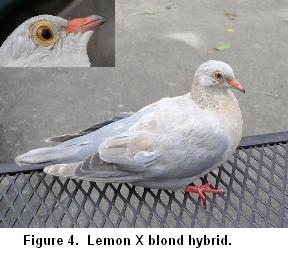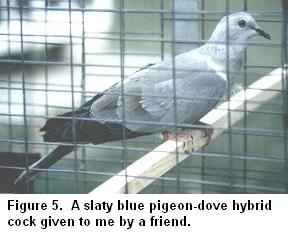The Lemon mutation in Pigeons (Columba livia) shares same
chromosome
location as Dilute-White in
Ring-necked Doves (Streptopelia
“risoria”).
by Robert J. Mangile
On page 82 of his book, "Origins and
Excursions in Pigeon Genetics",
Dr, Willard F. Hollander (1983) stated, "Sooner or later an
extreme-dilute mutation should pop up in the pigeon, like the white of
ring-dove." In 1997 Jack Barkel, of South Africa, found a new
color in pigeons that he labeled "Lemon". However, the plumage
coloration of Barkel's Lemons was variable shades of tan, depending on
the pattern and other mutants involved - not the assumed color of a
lemon. In May 2002 some of Barkel's Lemons were imported into the
United States and stock was distributed to several pigeon fanciers.
By April 2005 I had received one lemon check hen and a few Figuritas
from Jerry Sternadel. It was about that time when testing done by
Larry Davis demonstrated that the gene that produced the Barkel's Lemon
plumage was an allele to the sex-linked gene dilution (d) and was given
the genetic symbol "d
ex" for “extreme-dilute”. (See a
comprehensive article on Lemon by Larry Davis and Ron Huntley at
http://www.angelfire.com/ga/huntleyloft/lemon.html
) One question that needed answering: was the new
extreme-dilution gene in Barkel's Lemons the corresponding counterpart
of the ring-necked dove's sex-linked dilute-white (d
w)?
I was determined to find an answer to that question.
Discussion
Figuritas are among the smallest pigeon
breeds and by the end of 2008 I
had transferred the lemon coloration to small Figurita-like stock,
(Fig.1). During 2009 and 2010, matings #119 and #120, involving lemon
Figurita cocks to dilute-white ring-necked dove hens, produced
a combined total of forty-two (42) eggs. (Table:
1) Of the twelve that hatched, ten died within
a week or less. The two squabs that survived matured into near
white male hybrids with orange-red eyes, (Fig.2). All newly
hatched
squabs had very short down (naked), pink eyes, totally flesh-colored
bills and feet, and looked like albino hatchlings.
 In 2012, matings #121 and #122 (lemon cocks X blond hens)
produced a combined total of twelve
eggs, (Table: 1). Of the four that hatched, three died
before
fledge (at one day, 14 days and 18 days). The last squab from
#122 was not being fed properly and appeared to be failing at 15 days
of age. Its condition improved with assisted hand feeding with a
syringe, (Fig.4). It seemed exceptionally tame but I ultimately
realized it was blind. (I'm still hand feeding at four months of
age with hope it will learn to eat on its own.) All squabs from #121
and #122 had intermediate down length and displayed a bill ring similar
to blond dove squabs, (Fig 3). The mature eye color is an
orange-red similar to blond doves, the bill tip is dark, (Fig.4), the
plumage is darker than a blond dove – showing a gray back - and the
wattle is not powdery white, as in adult pigeons, but similar to
ring-necked doves. (On
May 24, 2015, approximately 12:15 A.M., the Lemon X Blond hybrid cock
#122 died of respiratory problems that grew increasingly worse over the
past year. It never learned to eat and drink and
was kept indoors and hand feed for two weeks shy of three years.
It hatched June 6, 2012.) [Click here to watch
& listen to its call at 9 months.]
In 2012, matings #121 and #122 (lemon cocks X blond hens)
produced a combined total of twelve
eggs, (Table: 1). Of the four that hatched, three died
before
fledge (at one day, 14 days and 18 days). The last squab from
#122 was not being fed properly and appeared to be failing at 15 days
of age. Its condition improved with assisted hand feeding with a
syringe, (Fig.4). It seemed exceptionally tame but I ultimately
realized it was blind. (I'm still hand feeding at four months of
age with hope it will learn to eat on its own.) All squabs from #121
and #122 had intermediate down length and displayed a bill ring similar
to blond dove squabs, (Fig 3). The mature eye color is an
orange-red similar to blond doves, the bill tip is dark, (Fig.4), the
plumage is darker than a blond dove – showing a gray back - and the
wattle is not powdery white, as in adult pigeons, but similar to
ring-necked doves. (On
May 24, 2015, approximately 12:15 A.M., the Lemon X Blond hybrid cock
#122 died of respiratory problems that grew increasingly worse over the
past year. It never learned to eat and drink and
was kept indoors and hand feed for two weeks shy of three years.
It hatched June 6, 2012.) [Click here to watch
& listen to its call at 9 months.]
Table 1. Four
pigeon X dove hybrid matings.
Pair No. 119, lemon check cock
(1516B) X dilute-white hen (100L)
32 eggs were produced - 19 infertile, 3 died as embryos,
10 hatched (9 died by day 7, 1 matured to white male)
|
Pair No. 120, lemon bar cock
(1551B) X dilute-white hen (6)
10 eggs were produced - 5 infertile, 2 died as embryos,
3 hatched (2 died by day 2, 1 matured to white male) |
Pair No. 121, lemon check cock
(1581A) X rosy-blond hen (14)
6 eggs were produced -1 infertile, 3 died as embryos,
2 hatched (both died at 14 days with blond plumage) |
Pair No. 122, lemon bar cock
(1581C) X blond hen (25)
5 eggs were produced – 1 infertile), 2 died as embryos,
2 hatched (1 died by day 2, 1 matured = blind blond male) |
All four matings were bred in
individual cages. Of the 53 eggs from
these four matings only 16 hatched. The surviving two
extreme-dilute hybrids from pair 119 and 120 displayed "black" in their
abdomens until about 15 days of age, as did two others that died at one
week old of age. Blackened abdomens were not noticed in the blond
hybrids from pair 121 and 122. Some newly hatched squabs were not
fed and died by the second day.
Comments and
Conclusions
In pigeon cocks heterozygous for lemon
and dilute (d
ex//d)
the plumage is noticeably lighter or brighter than in homozygous dilute
(d//d) cocks. And dove fanciers have observed that male blond doves
that are heterozygous for dilute-white and dilute-blond (d
w//d
B)
are of a lighter plumage than males homozygous for blond (d
B//d
B).
But in (d
ex//
dw) hybrids the lemon gene (d
ex)
seems to produce a “darker”, rather than lighter, plumage. And
the (d
ex//d
B) hybrids show a darker, bluish blond
plumage – not lighter as noticed in (d
B//d
w) male
doves.
The small amount of data from these four hybrid matings indicate that
the extreme-dilute gene found in Barkel's Lemons is a mirrored mutation
of the gene that produces dilute-white in ring-necked doves.
Lemon pigeon X white dove hybrid males (d
ex//d
w)
are nearly all white with a trace of tan overcast in areas of their
plumage. In lemon pigeon X blond dove matings the young hybrids
that survived long enough to produce feathers displayed blond plumage,
indicating allelism (d
ex//d
B) and that lemon is
recessive to blond. In blue (wildtype) pigeon X blond dove matings the
male offspring have "slaty" plumage (+//d
B). In
a hybrid mating (#110) outside this report two slaty blue hybrid males
were produced from a black Figurita cock X dilute-white dove hen.
No photographs were taken of these birds but an example of a slaty blue
hybrid male, given to me by a friend, can be seen in Figure 5.

On page 292 of the
American
Naturalist, Vol. LXXXIV, July-August 1950 "Hybrids of Pigeons by
Ring Dove" by Leon J. Cole and Willard F. Hollander they had this to
say.
"It was early discovered that if
a "dilute' pigeon were used with
either blond or white dove, the hybrids were all blond (= dilute),
quite distinct from the slaty "type hybrids". Apparently therefore
blond and dilute are essentially the same genetically."
Addressing the cause of the early embryonic death and high mortality of
nestlings in crosses of domestic pigeons,
Columba livia, and Ring-necked
doves,
Streptopelia "risoria",
Cole and Hollander, pages 286-287 had this to say.
"A study of the
immunogenetic features in this cross was reported by Irwin and Cole
(1936). The erythrocyte antigens of the hybrids include those of
both parental species, though some variation was noted in the pigeon
antigens represented. Also there was a new antigenic property or
"hybrid substance, " which was interpreted as an effect of
complementary action of genes governing antigenic properties,
(Analogous effects have been noted in other species hybrids.)"
And in December 2004, Dr. Wilmer Miller wrote the following on his web
site page "Pigeon/Dove Hybrids"
http://www.ringneckdove.com/Wilmer's
WebPage/pigeon_dove_hybrids.htm
"The red cell antigens have been
studied by several investigators.
Primarily, Professor M. R. Irwin [my major professor] utilized the
hybrids produced by Dr. L. J. Cole to show a mysterious "hybrid
substance" related to that found in pearlneck/ringneck,
senegal/ringneck, and other species hybrids also investigated by Irwin.
This was a great puzzle to geneticists of that time (1930's-40's),
since the hybrid substance was inherited as a dominant but not present
in either parental species. I was able to show that it is much like a
(serological) interaction product well known for other more ordinary
characters. Further, I showed that it resulted from the CC' red cell
species-specific antigenic complex of the cross of the triangular
spotted pigeon with the domestic pigeon. For more complex details see
my CV references. " # # #
*You can
download a four page PDF file of this article by clicking here.